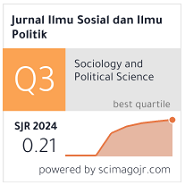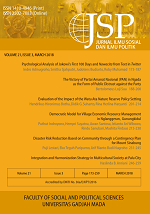Content Analysis of Social Media: Public and Government Response to COVID-19 Pandemic in Indonesia
Gugun Geusan Akbar(1*), Dede Kurniadi(2), Nita Nurliawati(3)
(1) Department of Social and Political, Universitas Garut, Indonesia
(2) Department of Informatics, Sekolah Tinggi Teknologi Garut, Indonesia
(3) Department of State Development Administration, Politeknik LAN Bandung, Indonesia
(*) Corresponding Author
Abstract
Nowadays, the use of social media to analyze disaster responses has become important. However, its application to support decision-making by the Government during disasters still present significant challenges. This article offers a complete analysis of the response of the public and the Government in dealing with the COVID-19 Pandemics in Indonesia. The content analysis uses to analyze the tweet post on Twitter to determine the public and government response. Data was collected from public and government tweets on Twitter and producing 11,578 community tweets from the public and 958 tweets from the government account. This data was collected from 2nd March until 15th April 2020. Public comments are sorted into six categories of comments, that is fate, logic, government mention, worry, scientist, and impression, while sentiments are classified as positive, negative, and neutral. Government comments are sorted into eight categories, namely information, education, operating, warnings, resources provision, volunteer recruitment, and rumors management. The results showed that the public encourages and supports the Government to cope with a pandemic think rationally and logically in dealing with this Pandemic. In addition, the study indicates that the Government has not used social media as a medium for communicating with the public. The quality of government response is not good, especially in the categories of information on operations, warnings, resources provision, recruitment of volunteers, and rumors management. The implication of this study suggests how the data might be useful for the Government in delivering information during the Pandemic.
Keywords
Full Text:
PDFReferences
Ahmed, S. F., Quadeer, A. A., & McKay, M. R. (2020). Preliminary identification of potential vaccine targets for the COVID-19 Coronavirus (SARS-CoV-2) Based on SARS-CoV Immunological Studies. Viruses, 12(3). https://doi.org/10.3390/ v12030254
Ahmed, W., Vidal-Alaball, J., Downing, J., & Seguí, F. L. (2020). COVID-19 and the 5G conspiracy theory: Social network analysis of twitter data. Journal of Medical Internet Research, 22(5), 1–9. https://doi. org/10.2196/19458
Akinboade, O. A., Kinfack, E. C., & Mokwena, M. P. (2012). An analysis of citizen satisfaction with public service delivery in the Sedibeng district municipality of South Africa. International Journal of Social Economics, 40(5), 458-478 https://doi. org/10.1108/03068291211199350
Al Tamimi, H., & Dwivedi, R. (n.d.). Critical Success Factor of Promoting Research and Innovation Interest among University Students: A Study of UAE/Dubai. FINAL CONFERENCE PROCEEDINGS, 34.
Alguliyev, R. M., Aliguliyev, R. M., & Niftaliyeva, G. Y. (2019). Extracting social networks from e-government by sentiment analysis of users' comments. Electronic Government, 15(1), 91–106. https://doi.org/10.1504/EG.2019.096576
Amrullah, A. Z., Sofyan Anas, A., & Hidayat, M. A. J. (2020). Analisis Sentimen Movie Review Menggunakan Naive Bayes Classifier Dengan Seleksi Fitur Chi Square. Jurnal Bumigora Information Technology (BITe), 2(1), 40–44. https://doi. org/10.30812/bite.v2i1.804
Branz, L ., & B roc kmann, P. (2018). Sentiment Analysis of Twitter Data. Proceedings of the 12th ACM International Conference on Distributed and Event- Based Systems - DEBS '18. https://doi. org/10.1145/3210284.3219769
Caddy, S. (2020). Developing a vaccine for covid-19. BMJ (Clinical Research Ed.), 369(May), m1790. https://doi.org/10.1136/ bmj.m1790
de Albuquerque, J. P., Herfort, B., Brenning, A., & Zipf, A. (2015). A geographic approach for combining social media and authoritative data towards identifying useful information for disaster management. International Journal of Geographical Information Science, 29(4), 667–689. https://doi.org/10.1080/13658816.2014.996567
De Salazar, P. M., Niehus, R., Taylor, A., Buckee, C. O., & Lipsitch, M. (2020). Using predicted imports of 2019-nCoV cases to determine locations that may not be identifying all imported cases. medRxiv, 2020.02.04.20020495. https://doi. org/10.1101/2020.02.04.20020495
Dhyani, S., Thakur, G. S., & Sahu, Y. (2019). Assorted sentiment analysis model for natural crisis response and recovery using big data driven technology. International Journal on Emerging Technologies, 10(4), 345–353.
Gao, J., Tian, Z., & Yang, X. (2020). Breakthrough: Chloroquine phosphate has shown apparent efficacy in treatment of COVID-19 associated pneumonia in clinical studies. BioScience Trends, 14(1), 72–73. https://doi.org/10.5582/ BST.2020.01047
Graham, M. W., Avery, E. J., & Park, S. (2015). The role of social media in local government crisis communications. Public Relations Review, 41(3), 386–394. https:// doi.org/10.1016/j.pubrev.2015.02.001
Gunawan, B., Pratiwi, H. S., & Pratama, E. E. (2018). Sistem Analisis Sentimen pada Ulasan Produk Menggunakan Metode Naive Bayes. Jurnal Edukasi Dan Penelitian Informatika (JEPIN), 4(2), 113. https://doi. org/10.26418/jp.v4i2.27526
Han, X., & Wang, J. (2019). Using social media to mine and analyze public sentiment during a disaster: A case study of the 2018 Shouguang city flood in China. ISPRS International Journal of Geo-Information, 8(4). https://doi.org/10.3390/ijgi8040185
Han, X., Wang, J., Zhang, M., & Wang, X. (2020). Using social media to mine and analyze public opinion related to COVID-19 in China. International Journal of Environmental Research and Public Health, 17(8). https://doi.org/10.3390/ ijerph17082788
Hughes, A. L., St. Denis, L. A., Palen, L., & Anderson, K. M. (2014). Online public communications by police & fire services during the 2012 Hurricane Sandy. Conference on Human Factors in Computing Systems - Proceedings, 1505–1514. https:// doi.org/10.1145/2556288.2557227
Kaila, R.P. & Prasad, A. V. K. (2020). Informational Flow on Twitter - Corona Virus Outbreak – Topic. International Journal of Advanced Research in Engineering and Technology ;11(3), 128–134.
La, V. P., Pham, T. H., Ho, M. T., Nguyen, M. H., Nguyen, K. L. P., Vuong, T. T., … Vuong, Q. H. (2020). Policy response, social media and science journalism for the sustainability of the public health system amid the COVID-19 outbreak: The vietnam lessons. Sustainability (Switzerland), 12(7). https://doi.org/10.3390/su12072931
Li, X., Geng, M., Peng, Y., Meng, L., & Lu, S. (2020). Molecular immune pathogenesis and diagnosis of COVID-19. Journal of Pharmaceutical Analysis, 10(2), 102–108. https://doi.org/10.1016/j.jpha.2020.03.001
Liu, C., Zhou, Q., Li, Y., Garner, L. V., Watkins, S. P., Carter, L. J., … Albaiu, D. (2020). Research and Development on Therapeutic Agents and Vaccines for COVID-19 and Related Human Coronavirus Diseases. ACS Central Science, 6(3), 315–331. https:// doi.org/10.1021/acscentsci.0c00272
Maylawati, D. S., Mudyawati, M. N., Wahisyam, M. H., & Maulana, R. A. (2021). Comparison of Classification Algorithms for Sentiment Analysis on Movie Comments. Gunung Djati Conference Series, 3, 68–80.
Merkley, E., Bridgman, A., Loewen, P. J., Owen, T., Ruths, D., & Zhilin, O. (2020). A Rare Moment of Cross-Partisan Consensus: Elite and Public Response to the COVID-19 Pandemic in Canada. Canadian Journal of Political Science, (May), 1–8. https://doi. org/10.1017/S0008423920000311
Muliawaty, L., Alamsyah, K., Salamah, U., & Maylawati, D. S. (2019). The concept of big data in bureaucratic service using sentiment analysis. International Journal of Sociotechnology and Knowledge Development. https://doi.org/10.4018/IJSKD.2019070101
Olapegba, P. O., Iorfa, S. K., Kolawole, S. O., Oguntayo, R., Gandi, J. C., Ottu, I. F. A., & Ayandele, O. (2020). Survey data of COVID-19-related Knowledge, Risk Perceptions and Precautionary Behavior among Nigerians. Data in Brief, 30, 105685. https://doi.org/10.1016/j.dib.2020.105685
Pastor, C. K. L. (2020). Sentiment analysis of Filipinos and effects of extreme community quarantine due to coronavirus (COVID-19) Pandemic. Journal of Critical Reviews, 7(7), 91–95. https://doi. org/10.31838/jcr.07.07.15
Prompetchara, E., Ketloy, C., & Palaga, T. (2020). Immune responses in COVID-19 and potential vaccines: Lessons learned from SARS and MERS epidemic. Asian Pacific Journal of Allergy and Immunology, 38(1), 1–9. https://doi.org/10.12932/AP-200220-0772
Putra, S. J., Khalil, I., Gunawan, M. N., Amin, R. I., & Sutabri, T. (2018). A hybrid model for social media sentiment analysis for Indonesian text. ACM International Conference Proceeding Series, 297–301. https://doi.org/10.1145/3282373.3282850
Ragini, J. R., Anand, P. M. R., & Bhaskar, V. (2018). Big data analytics for disaster response and recovery through sentiment analysis. International Journal of Information Management, 42(September 2017), 13–24. https://doi.org/10.1016/j. ijinfomgt.2018.05.004
Rekha, V., Raksha, R., Patil, P., Swaras, N., & Rajat, G. L. (2019). Sentiment Analysis on Indian Government Schemes Using Twitter data. 2019 International Conference on Data Science and Communication, IconDSC 2019, 1–5. https://doi.org/10.1109/ IconDSC.2019.8817036
Rodrigues, A. P., Rao, A., & Chiplunkar, N. N. (2018). Sentiment Analysis of Real Time Twitter Data Using Big Data Approach. 2nd International Conference on Computational Systems and Information Technology for Sustainable Solutions, CSITSS 2017, 1–6. https://doi.org/10.1109/ CSITSS.2017.8447656
Ruhyana, N. (2019). Analisis Sentimen Terhadap Penerapan Sistem Plat Nomor Ganjil/Genap Pada Twitter Dengan Metode Klasifikasi Naive Bayes. Jurnal IKRA-ITH Informatika, 3(1), 94–99.
Shull, P. B., Jiang, S., Zhu, Y., & Zhu, X. (2019). Hand gesture recognition and finger angle estimation via wrist-worn modified barometric pressure sensing. IEEE Transactions on Neural Systems and Rehabilitation Engineering, 27(4), 724–732. https://doi.org/10.1109/ TNSRE.2019.2905658
Sohrabi, C., Alsafi, Z., O'Neill, N., Khan, M., Kerwan, A., Al-Jabir, A., … Agha, R. (2020). World Health Organization declares global emergency: A review of the 2019 novel coronavirus (COVID-19). International Journal of Surgery, 76, 71–76. https://doi.org/10.1016/j.ijsu.2020.02.034
St. Denis, L. A., Palen, L., & Anderson, K. M. (2014). Mastering social media: An analysis of Jefferson County's communications during the 2013 Colorado floods. ISCRAM 2014 Conference Proceedings - 11th International Conference on Information Systems for Crisis Response and Management, (May), 737–746.
Sutton, J., Spiro, E. S., Johnson, B., Fitzhugh, S., Gibson, B., & Butts, C. T. (2014). Warning tweets: serial transmission of messages during the warning phase of a disaster event. Information Communication and Society, 17(6), 765–787. https://doi.org/10. 1080/1369118X.2013.862561
Thompson, C. J., Barber, K., & Bourget, E. M. (2018). STEAM (Science, Technology, Engineering, Art, and Mathematics) Education and Teachers' Pedagogical Discontentment Levels. PEOPLE: International Journal of Social Sciences, 4(3).
Vayansky, I., Kumar, S. A. P., & Li, Z. (2019). An Evaluation of Geotagged Twitter Data during Hurricane Irma Using Sentiment Analysis and Topic Modeling for Disaster Resilience. International Symposium on Technology and Society, Proceedings, 2019-November, 1–6. https:// doi.org/10.1109/ISTAS48451.2019.8937859
Wang, Z., & Ye, X. (2018). Social media analytics for natural disaster management. International Journal of Geographical Information Science, 32(1), 49–72. https:// doi.org/10.1080/13658816.2017.1367003
Worldmeter. (2020). Indonesia Corona Viruses Case. Retrieved January 2, 2021, from https://www.worldometers.info/ coronavirus/country/indonesia/
Wu, X., Zhu, X., Wu, G. Q., & Ding, W. (2014). Data mining with big data. IEEE Transactions on Knowledge and Data Engineering. https://doi.org/10.1109/ TKDE.2013.109
Wu, Z., & McGoogan, J. M. (2020). Characteristics of and important lessons from the coronavirus disease 2019(COVID-19) outbreak in China. Jama, 323(13), 1239–1242. https://doi. org/10.1001/jama.2020.2648
Wukich, C. (2016). Government Social Media Messages across Disaster Phases. Journal of Contingencies and Crisis Management, 24(4), 230–243. https://doi.org/10.1111/1468-5973.12119
Yamada, K. (2020). Public response to news reports on the Mount Kusatsu-Shirane volcanic eruption: A content analysis of online reader comments. International Journal of Disaster Risk Reduction, 43(July 2019), 101388. https://doi.org/10.1016/j. ijdrr.2019.101388
Article Metrics
Refbacks
- There are currently no refbacks.
Copyright (c) 2021 Jurnal Ilmu Sosial dan Ilmu Politik

This work is licensed under a Creative Commons Attribution-NonCommercial-NoDerivatives 4.0 International License.






















